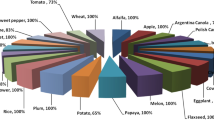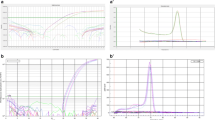Abstract
Presence of genetic modifications in rice products originating from China and imported to the European Union market is detected since 2006. Neither these products from China nor any other genetically modified rice lines are approved as food or feed in the EU. The transgenic rice varieties identified contain genetic elements and constructs coding for insect-resistance genes from Bacillus thuringiensis (Bt) coding for insecticidal crystal (cry) proteins. In particular, DNA sequences coding for codon-optimised or fused cry1Ab/c genes and constructs driven by the maize ubiquitin promoter (P-ubiZM1) were identified. For improved screening and identification of genetic modifications present in Asian rice products, two TaqMan-based real-time PCR assays targeting codon-optimised cry1Ab/Ac and the Pubi-cry construct have been developed. These assays have been validated in an international collaborative trial with 17 participants from 10 countries. Based on a new mathematical–statistical model and an adjusted experimental set-up of the collaborative trial, a close examination of the limit of detection (LOD 95%) and the probability of detection of the qualitative PCR assays was conducted. The evaluation of the method performance characteristics and results of the collaborative trial validation are presented.



Similar content being viewed by others
References
Li Y, Peng Y, Hallerman EM, Wu K (2014) Biosafety management and commercial use of genetically modified crops in China. Plant Cell Rep 33:565–573
Mäde D, Degner C, Grohmann L (2006) Detection of genetically modified rice: a construct-specific real-time PCR method based on DNA sequences from transgenic Bt rice. Eur Food Res Technol 224:271–278
Akiyama H, Sasaki N, Sakata K, Ohmori K, Toyota A, Kikuchi Y, Watanabe T, Furui S, Kitta K, Maitani T (2007) Indicated detection of two unapproved transgenic rice lines contaminating vermicelli products. J Agric Food Chem 55:5942–5947
Reiting R, Grohmann L, Mäde D (2010) A testing cascade for the detection of genetically modified rice by real-time PCR in food and its application for detection of an unauthorized rice line similar to KeFeng6. J Verbr Lebensm 5:185–188
Reiting R, Grohmann L, Moris G, Mäde D (2013) Detection and characterization of an unknown rice event in Basmati rice products. Eur Food Res Technol 236:715–723
Wang Y, Johnston S (2007) UNU-IAS working paper no 152 United Nations University-Institute of Advanced Studies, Yokohama, Japan, 2007. http://www.ias.unu.edu/resource_centre/152%20Yanqing%20Wang.pdf. Accessed 17 July 2014
Tu J, Zhang GA, Datta K, Xu CG, He YQ, Zhang QF, Khush GS, Datta SK (2000) Field performance of transgenic elite commercial hybrid rice expressing Bacillus thuringiensis d-endotoxin. Nat Biotechnol 18:1101–1104
RASFF Portal Notification List. https://webgate.ec.europa.eu/rasff-window/portal/index.cfm?event=notificationsList. Accessed 17 July 2014
Commission implementing Decision of 22 December 2011 on emergency measures regarding unauthorised genetically modified rice in rice products originating from China and repealing Decision 2008/289/EC (2011/884/EU)
EU-RL GMFF revised guidance on the detection of genetically modified rice originating from China using real-time PCR for the detection of P-35S, T-nos and Cry1Ab/Ac. http://gmo-crl.jrc.ec.europa.eu/doc/EURL-MV-01-11.pdf Accessed 17 July 2014
Gasparic MB, Tengs T, La Paz JL, Holst-Jensen A, Pla M, Esteve T, Zel J, Gruden K (2010) Comparison of nine different real-time PCR chemistries for qualitative and quantitative applications in GMO detection. Anal Bioanal Chem 396:2023–2029
Ministry of Agriculture of the People’s Republic of China (2007) Detection of genetically modified plants and their derived products: qualitative PCR methods for Bt rice to control insect pests. Bulletin 953-6-2007. http://www.stee.agri.gov.cn/biosafety/wnlj/P020080214405619156076.doc. Accessed 17 July 2014
ISO 21571 Foodstuffs—methods of analysis for the detection of genetically modified organisms and derived products—nucleic acid extraction. Annex B
Grohmann L, Mäde D (2009) Detection of genetically modified rice: collaborative validation study of a construct-specific real-time PCR method for detection of transgenic Bt rice. Eur Food Res Technol 228:497–500
Arumuganathan K, Earle ED (1991) Nuclear content of some important plant species. Plant Mol Biol Rep 9:208–218
Uhlig S, Frost K, Colson B, Simon K, Mäde D, Reiting R, Gowik P, Grohmann L (2014) Validation of qualitative PCR methods on the basis of mathematical—statistical modelling of the probability of detection. Accred Qual Assur (this issue). doi:10.1007/s00769-015-1112-9
Perlak FJ, Fuchs RL, Dean DA, McPherson SL, Fischhoff DA (1991) Modification of the coding sequence enhances plant expression of insect control protein genes. Proc Natl Acad Sci USA 88:3324–3328
Wang Y, Johnston S (2007) The status of GM rice R&D in China. Nat Biotechnol 25:717–718
Deka S, Barthakur S (2010) Overview on current status of biotechnological interventions on yellow stem borer Scirpophaga incertulas (Lepidoptera: Crambidae) resistance in rice. Biotechnol Adv 28:70–81
Biosafety Clearing-House (BCH) central internet portal http://bch.cbd.int/database/record.shtml?documentid=14750. Accessed 17 July 2014
Biosafety Clearing-House (BCH) central internet portal http://bch.cbd.int/database/record.shtml?documentid=43773. Accessed 17 July 2014
Randhawa GJ, Singh M, Chhabra R, Sharma R (2010) Qualitative and quantitative molecular testing methodologies and traceability systems for commercialised Bt cotton events and other Bt crops under field trials in India. Food Anal Methods 3:295–303
Horwitz W (1995) Protocol for the design, conduct and interpretation of method performance studies. Pure Appl Chem 67:331–343
Guidelines on performance criteria and validation of methods for detection, identification and quantification of specific DNA sequences and specific proteins in food. CAC/GL 74-2010 http://www.fao.org/fileadmin/user_upload/gmfp/resources/CXG_074e.pdf. Accessed 17 July 2014
European Network of GMO Laboratories (ENGL) (13 October 2008) Definition of minimum performance requirements for analytical methods of GMO testing. http://gmo-crl.jrc.ec.europa.eu/doc/Min_Perf_Requirements_Analytical_methods.pdf. Accessed 17 July 2014
ISO 5725-2 (December 2002) Accuracy (trueness and precision) of measurement methods and results—part 2: basic method for the determination of repeatability and reproducibility of a standard measurement method
Broeders S, Huber I, Grohmann L, Berben G, Taverniers I, Mazzara M, Roosens N, Morisset D (2014) Guidelines for validation of qualitative real-time PCR methods. Trends Food Sci Technol 37:115–126
Clopper CJ, Pearson ES (1934) The use of confidence or fiducial limits illustrated in the case of the binomial. Biometrika 26:404–413
Grohmann L, Brunen-Nieweler C, Nemeth A, Waiblinger HU (2009) Collaborative trial validation studies of real-time PCR-based GMO screening methods for detection of the bar gene and the ctp2-cp4epsps construct. J Agric Food Chem 57:8913–8920
Guidance document from the European Network of GMO laboratories (ENGL) (2011) Verification of analytical methods for GMO testing when implementing interlaboratory validated methods. EUR 24790 EN; ISBN 978-92-79-19925-7. http://gmo-crl.jrc.ec.europa.eu/doc/ENGL%20MV%20WG%20Report%20July%202011.pdf. Accessed 17 July 2014
Wehling P, LaBudde RA, Brunelle SL, Nelson MT (2011) Probability of detection (POD) as a statistical model for the validation of qualitative methods. J AOAC Int 94:335–347
Uhlig S, Niewöhner L, Gowik P (2011) Can the usual validation standard series for quantitative methods, ISO 5725, be also applied for qualitative methods? Accred Qual Assur 16:533–537
McArthur R, von Holst C (2012) A protocol for the validation of qualitative methods of detection. Anal Methods 4:2744–2754
Uhlig S, Krügener S, Gowik P (2013) A new profile likelihood confidence interval for the mean probability of detection in collaborative studies of binary test methods. Accred Qual Assur 18:367–372
Wang WX, Zhu TH, Lai FX, Fu Q (2011) Event-specific qualitative and quantitative detection of transgenic rice Kefeng-6 by characterization of the transgene flanking sequence. Eur Food Res Technol 232:297–305
Wang WX, Zhu TH, Lai FX, Fu Q (2012) Event-specific qualitative and quantitative detection of transgenic rice Kefeng-8 by characterization of the transgene flanking sequence. Eur Food Res Technol 234:477–484
Acknowledgments
The authors are very grateful to Christine Degner (Landesamt für Verbraucherschutz, Halle), Sigrid Niendorf (Landesamt für Verbraucherschutz, Halle) and Franziska Duda (Hessisches Landeslabor, Kassel) for their excellent technical assistance during this study. We would like to thank Joachim Bendiek (BVL, Berlin) for carefully reading the manuscript and for helpful comments. The authors are grateful to the participants of the collaborative trial, namely Bayerisches Landesamt für Gesundheit und Lebensmittelsicherheit (Oberschleißheim, Germany); Bundesamt für Gesundheit (Bern, Switzerland); Chemisches und Veterinäruntersuchungsamt (Freiburg, Germany); Chemisches und Veterinäruntersuchungsamt Münsterland Emscher-Lippe (Münster, Germany); Chinese Academy of Inspection and Quarantine, Agro-Product Safety Research Center (Bejing, China); Service Commun des Laboratoires (Illkirch, France); Eurofins GeneScan Inc. (Metairie, USA); Genetic ID (Augsburg, Germany); Hessisches Landeslabor (Kassel, Germany); Institut für Hygiene (Hamburg, Germany); Joint Research Centre (Ispra, Italy); Kantonales Labor (Zürich, Switzerland); Laboratoire national de Santé (Luxembourg, Luxembourg); Landesamtes für Verbraucherschutz und Lebensmittelsicherheit (Braunschweig, Germany); National Research Centre on DNA Fingerprinting National Bureau of Plant Genetic Resources (New Dehli, India); Österreichische Agentur für Gesundheit und Ernährungssicherheit (Wien, Austria); and RIKILT Wageningen UR (Wageningen, the Netherlands).
Author information
Authors and Affiliations
Corresponding author
Rights and permissions
About this article
Cite this article
Grohmann, L., Reiting, R., Mäde, D. et al. Collaborative trial validation of cry1Ab/Ac and Pubi-cry TaqMan-based real-time PCR assays for detection of DNA derived from genetically modified Bt plant products. Accred Qual Assur 20, 85–96 (2015). https://doi.org/10.1007/s00769-015-1108-5
Received:
Accepted:
Published:
Issue Date:
DOI: https://doi.org/10.1007/s00769-015-1108-5




